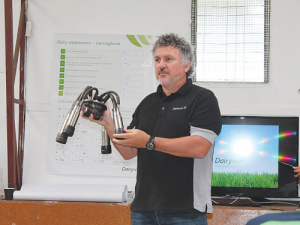DairyNZ has put together in-depth tools and animations on how to milk efficiently while ensuring cow health.
Rural News talked to milk quality consultant Josh Wheeler, at a Mini Milksmart event in Helensville for more information.
The tools are for helping farmers train staff members to milk efficiently and timely so that cows remain productive and healthy, Wheeler says.
Wheeler and DairyNZ scientist Dr Paul Edwards are taking their Efficient Milking module nationwide in February and March. Theirs is one of three DairyNZ Mini Milksmart modules; the other two are Understanding your cows to reduce mastitis and What’s blocking your track -- people or cows?
Wheeler and Edwards discussed a commonsense approach to improving milking times while maintaining cow health, including operating procedures for rotary and herringbone platforms. The tools are now also available on the DairyNZ website.
One example is stripping to look for mastitis. Wheeler says in most countries -- except for New Zealand, Australia and parts of Uruguay and Argentina -- milkers wash teats before milking.
Our farmers understand well – and given NZ milk quality it is understandable – that if the cows you are cupping are clean, the bacterial risk is very low, Wheeler says.
“If dirt is dry we should be wiping it off, if it is wet we should be washing and wiping.”
Farmers are always on the lookout for mastitis and in this country we can look at our routines and the frequency of stripping cows.
Milkers in developing countries have to strip every cow before cupping. It can take a lot of stripping time to find one cow with mastitis.
“A Kiwi farmer would look at that logically and think ‘I can get away with watching my cell count because I get a daily feedback, and maybe strip once a month in low risk times and once a week in high risk times’,” says Wheeler.
“To keep the milking routine working we either have another person help us strip or, when we are attaching the cups we might decide to strip the back left quarter this morning and the back right tonight so we can do it all as one process.
“We might get the two teats on Monday and Tuesday during spring – four teats, four milkings -- to get the coverage.”
DairyNZ’s Milksmart material recommends milking procedures for herringbone and rotary that are efficient and also maintain cow health.
“All milking tasks are to be completed calmly and consistently at every milking so that cows get used to the routine to help milking run smoothly,” DairyNZ says.
Rotary
Backing gate: move the gate little and often to take up the space in the yard to keep the cows flowing onto the platform.
Stay at cups-on: call the cows onto the platform. If a cow hesitates, step backwards from cupping position to encourage it on. Milkers should only enter the yard away from the entry when absolutely necessary.
Udder preparation: if cows teats are clean and dry, go ahead and cup; dry but dirty, wipe first then cup; wet and dirty, wash then dry cup.
The platform: Set the platform speed to suit your cupping speed
Don’t back the platform up for cows, keep the platform moving
Stop the platform if there is a risk of a cow or person getting hurt or when training cows to exit the platform
Don’t allow cows to ‘free ride’; all cows should exit after the clusters are removed.
In-bail feeders: check the feed is flowing correctly during milking.
Milking behaviour: keep milking calm and relaxed – no yelling or hitting cows.
Teat spraying: spray all cows teats after every milking. Spray to cover all surfaces of the teats.
Hose down during milking: keep the bridge and platform clean during milking.
Cow health: draft and record any cows that look lame and sick for checking after milking.
The milking plant: listen and watch the plant during milking to make sure it is working properly.


















